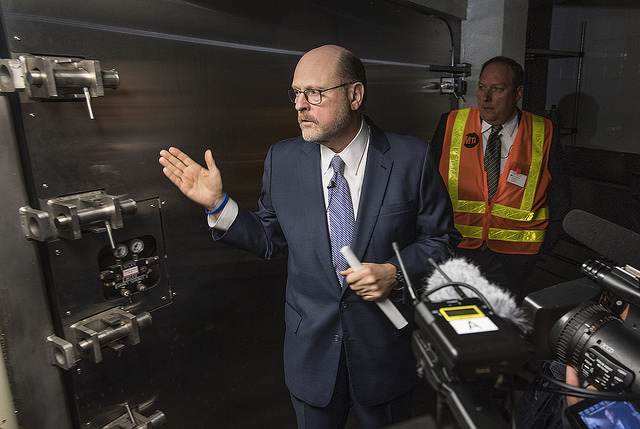Joe Lhota’s Resignation from the MTA: What You Need to Know
The outgoing chair leaves the transit authority stuck in the same crisis he was tasked to solve.

Could real leadership be around the corner?
MTA Chairman Joe Lhota resigned on Friday, after just 16 months atop the nation’s largest transit system.
Governor Cuomo appointed Lhota in June of last year, just as the subway crisis was becoming a national embarrassment (for him). Lhota carried the governor’s water, never criticizing his de facto boss publicly and, instead, harping on Mayor de Blasio to help fund subway repairs. Lhota ignored challenges of the governor’s making — such as the fact that the state is still $7.3 billion short on its contribution to the MTA’s current capital plan.
Lhota’s full-time job as chief of staff of the NYU-Langone hospital system gave him little time to advocate for the transit system. Instead, Andy Byford, whom Lhota hired as buses and subways chief in January, emerged as the MTA’s most forceful advocate. That left the rest of the system, including the crumbling Long Island Rail Road, without a champion.
So what does Lhota’s departure mean? Let’s begin:
Does this mean the subway crisis is over?
When he came on as chair, Lhota said his goal was to get the agency back on track. He declared “Mission Accomplished” in his resignation statement: “The Subway Action Plan was developed in my first month at the MTA and it has successfully arrested the subway’s decline,” he said.
That assessment is not totally wrong: The subways have in fact posted improving numbers in the last few months, but the $836 million subway action plan — introduced way back in July 2017 — isn’t why.
“They’ve seen basically one or two months of better numbers,” said Jon Orcutt of TransitCenter. “You couldn’t point to anything earlier this year that showed that one year of the subway action plan was making an impact.”
Meanwhile, any straphanger can tell you that whatever Lhota may have accomplished wasn’t enough. On Friday alone, signal problems forced the MTA to stop M train service altogether — and caused delays on even more lines, Gothamist reported. Incidents of that sort continue to be a regular occurrence.
So what did Lhota actually accomplish?
The chief accomplishment of Lhota’s tenure, Orcutt said, was hiring Andy Byford, the man tasked with restoring the city’s subways and buses to their former glory.
In Byford, Lhota and Cuomo found someone who knew how to fix a transit system and, perhaps more importantly, could be a neutral advocate for the agency trusted by everyone — including Cuomo’s political adversaries. Even as they hit Cuomo for letting the subways crumble, both primary challenger Cynthia Nixon and Republican gubernatorial nominee Marc Molinaro praised Byford. Mayor de Blasio has also expressed confidence in Byford’s leadership.
But the MTA faces a credibility problem that extends far past Byford’s perch at New York City Transit. The Long Island Rail Road has struggles not unlike those facing the subways. MTA capital projects across the board continue to go over-budget and past their deadlines.
“One of the things that did not happen in the last few years sufficiently was clear accountability about how money was spent, including the money the city has contributed to the MTA,” de Blasio told WNYC’s Brian Lehrer on Friday morning.
He’s right.
What’s next for the MTA?
Byford has been able to advocate for the subways and buses while taking responsibility for the challenges they face. The next chairperson must do that for the entire agency, advocates told Streetsblog. Otherwise, state legislators will be loath to provide it with badly needed funding or pass congestion pricing.
“We need somebody who’s going to get out there and talk about what’s changing inside the MTA,” said Nick Sifuentes of the Tri-State Transportation Campaign. “The next chair needs to tell a new story about the MTA, or it’s going to be brutally hard to get the resources from Albany.”
“The politics that the MTA chairman needs to be playing are the politics of getting the funding that the MTA needs, not the politics of weighing in on the squabbles between the city and the state.”
One thing is certain: another part-time chief executive won’t cut it.
“The MTA badly needs a full-time CEO. It’s a humongous, sprawling enterprise,” said John Kaehny of the good-government group Reinvent Albany. “It’s the biggest state government entity. If you said the head of the state DOT was working full-time as a dentist, people would think you’re completely crazy. It’s a massive job.”
The newly elected Democratic state senate could be instrumental in ensuring that, or they could pass the buck to Cuomo as they did when he appointed Lhota last year: The state senate received and approved the appointment in mere hours. A “confirmation hearing,” if you could call it that, took place via video conference at around midnight. Lhota’s controversial board membership at the Madison Square Garden Company, whose 21,000-seat arena is a key impediment to improving Penn Station, never even came up.
“We would have loved a full-time, committed Joe Lhota, but a half-time and fully compromised Joe Lhota had to go,” Kaehny said. “It’s a good opportunity for the Democratic majority in the senate to finally hold real hearings.”





